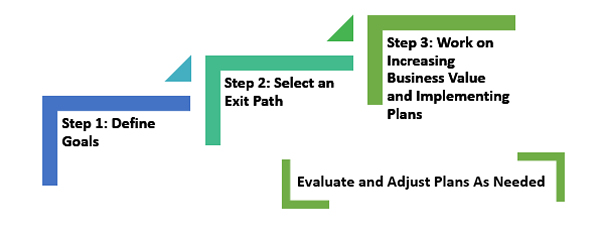Exit Planning: Successfully Exiting Your Business
Consider These Three Steps for Successfully Exiting Your Business
By Thomas Insalaco, Manager, Advisory Services
Imagine the following scenario: You have come to the decision to retire, only to find that your business, and subsequently your net worth, is not sufficient to sustain your current or desired lifestyle. This could be because your business is not worth as much as you expected, or that your business does not have the transferrable value you expected. The result is either postponing the next phase of your life and continuing work, or accepting a lower standard of living in retirement than desired. Fortunately, some, even basic, planning can help to increase the likelihood of a successful transition.
The most valuable asset of many self-employed individuals is their business. According to the Exit Planning Institute (https://exit-planning-institute.org/), approximately 4.5 million businesses, representing more than $10 trillion in value, will transition ownership over the next ten years. Yet, only 20 to 30 percent of businesses that are brought to market end up selling.
How soon should you start planning for an ownership transition? All business owners will eventually have to transition ownership, whether voluntarily or involuntarily. Shareholder disputes, divorce, disability, death, or other events can lead to an unexpected need to exit the business. So, preemptive planning is a beneficial practice, regardless of when you expect to exit.
Exit Planning Goals
What is a successful exit? There are three levels of exit goals to consider:
- Financial Independence – arriving at your exit date with sufficient assets to continue to fund your basic needs for the remainder of your retirement;
- Common Goals – achieving certain common goals including: (i) having enough assets to fund the level of lifestyle you desire, in excess of assets required for your basic needs; (ii) exiting at a preferable date; and (iii) choosing the next owner of the business.
- Values-Based Goals – evaluating and considering other items that may be important to the owner, such as leaving a legacy, acknowledging and rewarding certain employees, maintaining culture, minimizing taxes, and charity.
The first goal of financial independence is a baseline; without it, the exit would be a failure. A well-planned and successful exit not only achieves financial independence, but also the desired combination of common and value-based goals.
The Exit Planning Process

Step 1: Define Goals
- Measure Asset Gap
- Valuation of Business
- Expected Returns on Current Portfolio
- Estimated Assets Needed at Exit
- Estimate Exit Date
- Decide Who You Would Like to Sell to
- Value-Based Goals
Step 2: Select an Exit Path
- Select an Exit Path
- Sell to Insiders (Key Employees or Management)
- Employee Stock Ownership Plan
- Sell to a Third Party
- Sell/Transition to Children
- Selection of a Team of Professionals
- Valuation/Financial Advisor
- CPA – estate and tax planning
- Wealth Planner
- Others Depending on Goals and Exit Path
Step 3: Work on Increasing Business Value and Implementing Plans
- Reduce Risks
- Succession Planning
- Reduce Concentration Risks
- Insurance/Buy-Sell Agreements
- Growth of Investment Returns
- Dividend/Reinvestment decisions
- Capital Allocation
- Estate and Tax Planning
Asset Gap
Exit planning starts with assessing the owner’s asset gap—the difference between the owner’s net worth and what the owner requires on the exit date to sustain his/her desired lifestyle through retirement. To estimate the asset gap, the owner will need to have reasonable and realistic estimates of: (i) the value of the business; (ii) expected returns from their business; (iii) transaction costs and taxes when exiting; (iv) returns on other assets; (v) life expectancy; and (vi) an estimate of post-exit income needed to maintain the desired lifestyle. Often times, a business owner’s net worth may be significantly impacted by the business’s value. Additionally, in many cases, owners over-estimate their company’s value and expected returns on their assets, and under-estimate their post-exit income needs.
A valuation professional can help determine the value of the business and expected returns on the business. A tax professional can help estimate taxes upon sale of the business. A wealth planner can help determine an estimate of returns on other assets in a portfolio and determine post-exit income necessary to maintain a lifestyle. These pieces collectively will provide an estimate of the owner’s asset gap.
If the asset gap is wide and the owner’s preferred exit date is soon, then either the owner will need to lower expectations for post-exit lifestyle or be flexible on the exit date. This is why it is important to measure the asset gap as far ahead of the owner’s preferred exit date as possible—more time will allow for a wider and less risky set of options to close the asset gap and increase the likelihood of a successful exit.
Defining Goals
In addition to calculating the asset gap and selecting a preferred exit date, the owner will need to consider if they have a preference for who they would like to succeed them in leading and owning the business. The owner will also need to consider any value-based goals, such as leaving a legacy or maintaining the business culture. Finally, the owner should give thought to whether he/she is ready to relinquish ownership and what they will do with their time now that they no longer will be involved in the business.
Now that the goals are defined, the next step in the process is selecting an exit path and a team of advisors. The goals of the owner will help guide which path is best to take. A brief summary of the main advantages and disadvantages of each category of exit path is as follows.
Sell to Insiders (Key Employees, Management, or Co-Owners)
Selling to insiders allows for more flexibility in terms of time and deal structure. Additionally, when key employees or management are buyers, they become naturally motivated to ensure the productivity and profitability of the company. Key employees can be rewarded while maintaining the company’s culture.
The main disadvantage to this exit path is that the transition period is often lengthier, and the owner generally does not receive a payout upfront, since securing the necessary funding can be difficult for the buyers; the buyers may never be able to secure third-party financing, and the owner may have to hold a note. This leaves the owner exposed to business risk for a longer period of time while also expending a significant amount of effort to transition responsibilities and involvement in daily operations.
Transfer or Sale to Children or Family
Similar to transitioning a business to insiders, this exit path allows for more flexibility in terms of time and deal structure. An added benefit is that estate and tax planning can potentially help to reduce taxes and increase family wealth.
This exit path can also take longer for the owner to completely separate from the business (if separation from the business is desired). It may also be a challenge for the owner to assess without bias whether the children or family members are willing and able to run the business successfully. Similarly, if there are multiple children or family members involved in the business, choosing the right successor to lead while keeping everyone happy may be a challenge.
Sale to a Third Party
This exit path potentially provides for a quicker exit and greater sales price relative to the other exit paths, if the business is attractive to potential strategic buyers.
The downside to this approach is that selling to a third party may bring certain changes to the business. A strategic buyer is paying a higher price because they believe certain strategic changes can be made to the business to improve results. As a result, this path may not be a desired approach for an owner who wants to leave a legacy, keep the company’s culture intact, or keep longtime employees.
Sale to an Employee Stock Ownership Plan (“ESOP”)
The main benefits of selling to an ESOP are the ability to obtain partial liquidity, to gradually transition equity in stages, to achieve tax benefits, the ability to leave a legacy, and reward employees.
The main downside to this exit strategy is that the transaction itself can cause the company to incur a large amount of debt, so proper planning is necessary to ensure the company will have the cash flow to pay down the debt. Additionally, a portion of the debt is often seller-funded, creating some additional risk to the owner.
Other Considerations
Once goals are set and a path is chosen, work begins to prepare the business for the chosen transaction path and to close the asset gap (if one exists). Regardless of which exit path is contemplated, there are several important considerations that should be undertaken to increase the business’s value or attractiveness to buyers.
Concentration risks should be reduced where possible. If a significant portion of revenues are tied to one customer, supplies are bought from a single vendor, one employee bears a disproportionate amount of responsibility, or other similar concentrations exist, efforts should be made to reduce these risks.
Succession planning and preparing for the next generation of leaders can be accomplished by putting into place, or updating, appropriate insurance requirements and buy-sell agreements, or other relevant operating agreements.
Returns should be enhanced to the maximum extent possible. This can be achieved through dividend and reinvestment policy. If the business is in a mature, low-growth industry, dividends may need to be maximized and utilized by the owner to invest in assets that optimize their risk-reward profile. If the business is in a growth industry, reinvestment into the business should be the main focus, with capital allocation decisions carefully considered.
Considerations to reduce risks, increase growth, and improve the marketability of the business is ongoing throughout the exit planning process. As such, the process and progress should be evaluated periodically, and adjustments to goals and selection of the exit path should be made as necessary. The exact path to exit will be different in every case, depending on the owner’s starting point, timeline and goals, the chosen strategy, the industry the business operates in, and many other factors. Therefore, it is important to have the right advisors in place to ensure the best chance of a successful exit.
Marcum offers many services to those in the exit planning process, including business valuation, wealth planning, estate planning, tax planning, and ESOP sell-side advisory services. Additionally, we can help guide you through your exit by “quarterbacking” the process.



















